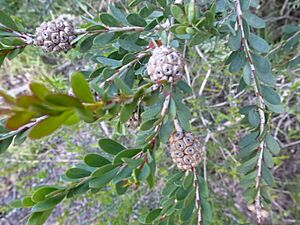Showy honey-myrtle facts for kids
Quick facts for kids Showy honey-myrtle |
|
|---|---|
 |
|
| M. nesophila in the Barcelona Botanic Garden | |
| Scientific classification | |
| Genus: |
Melaleuca
|
| Species: |
nesophila
|
| Synonyms | |
|
|
The Showy Honey-Myrtle, also known as Pink Melaleuca or mindiyet (its Noongar name), is a beautiful plant. It belongs to the myrtle family, called Myrtaceae. This plant is special because it grows naturally only in a small area near Albany in Western Australia.
The Showy Honey-Myrtle is a tough and flexible plant. It has many leaves that grow close together, forming a thick top. In late spring and summer, it produces lots of pink or purple flowers. Because it's so pretty and easy to grow, it's one of the most popular types of melaleuca shrubs grown in gardens.
Contents
What Does the Showy Honey-Myrtle Look Like?
The Showy Honey-Myrtle can grow as a large shrub or a small tree. It usually reaches about 4.7 to 6 meters (15 to 20 feet) tall. It can also spread out, becoming 4 to 5 meters (13 to 16 feet) wide.
Its bark is a grayish-white color and feels like paper. The plant has many leaves that grow close together. These leaves often reach all the way down to the ground.
Leaves and Flowers
The leaves of the Showy Honey-Myrtle are arranged one after another along the stem. They are about 11 to 26 millimeters (0.4 to 1 inch) long. They are also 4 to 9 millimeters (0.1 to 0.4 inches) wide. The leaves are flat and shaped like a narrow egg, with rounded ends.
The flowers are a lovely lavender to rose pink color. They look like "pom-poms" and bloom for a long time, from spring through mid-summer. These flowers grow in round clusters or short spikes at the ends of branches. The branches keep growing even after the flowers appear. Sometimes, flowers also grow where the upper leaves meet the stem.
Each flower cluster can be up to 30 millimeters (1.2 inches) across. Inside each cluster, there are usually 2 to 20 groups of three flowers.
Fruits
After the flowers, the plant produces woody fruits called capsules. These capsules are about 3 to 5 millimeters (0.1 to 0.2 inches) long. They grow together in round clusters, which are about 20 millimeters (0.8 inches) across.
Where Does the Showy Honey-Myrtle Grow?
The Showy Honey-Myrtle is found in specific areas of Western Australia. These areas include the Gairdner River and East Mount Barren districts. It also grows on islands close to the coast.
This plant prefers to grow in sandy soil. You can often find it near quartzite rocks, usually in thick scrubland.
How People Use the Showy Honey-Myrtle
The Showy Honey-Myrtle is a very popular plant for gardens. Plant nurseries grow it to sell to people who want to make their gardens beautiful. It's also used in xeriscaping, which is a type of landscaping that uses plants that don't need much water.
People plant it as a flowering shrub. If it's trained properly, it can also grow into a small ornamental tree. It grows well in sunny spots or places with some shade. It can live in sandy or clay soils. Once the plant is settled, it can handle long dry periods. It also does well in coastal areas where there might be salty air.
Plant Name and History
The scientific name for this plant is Melaleuca nesophila. It was first officially described in 1862 by a scientist named Ferdinand von Mueller. He wrote about it in his book Fragmenta Phytographiae Australiae. The plant he studied was found on the rocks of the Doubtful Islands near Bremer Bay.
The second part of its scientific name, nesophila, comes from ancient Greek words. "Nēsos" means "island," and "philein" means "to love." This name refers to where the first plant specimen was found: on an island.
Showy Honey-Myrtle and the Environment
In some parts of Victoria, the Showy Honey-Myrtle has spread naturally. However, it's sometimes seen as an environmental weed there. This is because it can grow so well that it takes over areas where native plants used to grow.
Conservation Status
The good news is that the Government of Western Australia's Department of Parks and Wildlife has classified this species as "not threatened." This means it's not currently in danger of disappearing.


